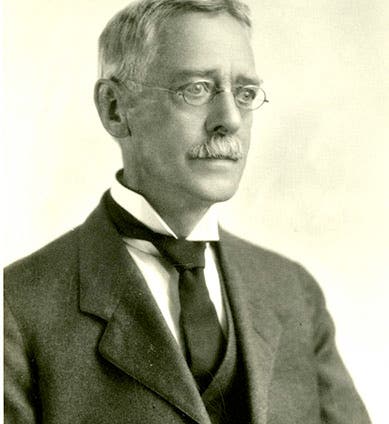Scientist of the Day - Henry Van Peters Wilson
Henry Van Peters Wilson, an American biologist, was born Feb. 16, 1863. The Wikipedia article on Wilson is two sentences long, which suggests either that Wilson does not belong in these posts, or that Wikipedia has some catching up to do. We prefer that later explanation, because Wilson clearly deserves to be remembered for one of the great demonstration experiments in the history of the life sciences.
First, a little about his career. He studied at Johns Hopkins University, intending to pursue medicine as a career, but was sidetracked by experimental zoology. He soon began to focus on invertebrates, especially sponges, with which he became enamored when he spent some months at Green Turtle Cay in the Bahamas. He went to work for what would become the U.S. Bureau of Fisheries, and spent almost ten years studying and describing the sponge collection that Alexander Agassiz brought back from his voyage on the Albatross. In 1891, Wilson was hired by the University of North Carolina (UNC) to teach zoology, and he would remain there for his entire career.
In 1903, Wilson became interested in the life cycle of the red oyster sponge, Microciona. I know nothing about sponges, so I don't know what makes Microciona a more appropriate subject than, say, a branching vase sponge, although its red color does make it attractive (second image). Sometime around 1904, Wilson discovered that, if you let the sponges sit around long enough, so that they start to degenerate, tiny bits of sponge fragments would start to regenerate, eventually forming tiny but complete sponges. This seemed extraordinary, and Wilson would eventually publish these results in a paper in Science in 1907, extracts from which we show here. You might note that the sponge he describes in the paper is not Microciona, but Stylotella. It is not as pretty as Microciona, so I did not use its photograph here.
But before that paper came out, Wilson envisioned the experiment for which he is best remembered. What would happen, he apparently wondered, if one broke down a sponge entirely, into its individual cells? Would they do anything? To find out, he took a piece of an oyster sponge, broke it into fragments, and then strained the entire mass through a fine mesh sieve into a container of sea water. The sponge was reduced to a cloud of organic material, seemingly lifeless, as it certainly would have been, had this started out as a mouse or a peony. But the sponge cells lived, and even better, they slowly began to aggregate, until they formed clumps, and then larger clumps. After some weeks, small but fully functional sponges had formed. Never before had anyone observed an organism, pulverized to near oblivion, reconstruct itself as if nothing had happened.
Wilson announced the results of this experiment in 1907, in the Journal of Experimental Zoology. We have this journal in our Library, but unfortunately, our run doesn't begin until 1916, so I cannot show you this paper. But I can connect you to a short video, narrated by David Attenborough, that recreates Wilson's famous experiment (admittedly using some fancy lab equipment, like mesh-screen syringes, that were not available to Wilson). But the results are still astonishing. Biologists are still trying to understand what sponge regeneration tells us about the nature of being an organism.
Another reason why this is one of the famous lab experiments in the history of science is that it is easy for students to reproduce in the lab. Most experiments are not like that. I think the Millikan oil-drop experiment (to determine the charge on an electron) is notable mostly because anyone can do it, provided you have a microscope, two electrified plates connected to a rheostat, and a sprayer that will produce fine oil droplets. I have done it, and so have tens of thousands of physics students. And I suspect that thousands of invertebrate zoology students have gleefully ground up their sponge specimens, forced them through a sieve, and then spent the rest of the semester observing the slow surprise that life often has to offer us.
Wilson had a long career at UNC. He has been described as a small man, 120 poundsd or so, with very intense eyes, quite meticulous in his habits, and utterly unforgiving of the foolish or misinformed. I do not know if he got weary of being remembered as the sponze pulverizer, as Maurice Ravel got sick of being introduced as the composer of Bolero, but perhaps he did not. It was, after all, a terrific experiment.
Dr. William B. Ashworth, Jr., Consultant for the History of Science, Linda Hall Library and Associate Professor emeritus, Department of History, University of Missouri-Kansas City. Comments or corrections are welcome; please direct to ashworthw@umkc.edu.








